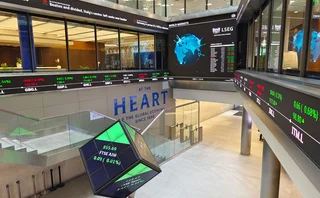
Law firm of the year: Linklaters
Risk Awards 2025: Law firm’s work helped buttress markets for credit derivatives, clearing and digital assets

One group is vital to the orderly running of the one hundred-billion-dollar credit derivatives market, deciding on whether credit default swap payouts are warranted, among other procedural matters. But the work of the determinations committees (DCs) is held in suspicion in some quarters, and membership has been dwindling.
Law firm Linklaters is providing direction for much-needed reforms that would strengthen the governance of the DCs, whilst resolving perceived conflicts of interest and opaqueness.
“At the moment, the DC effectively marks its own homework,” says Simon Firth, a partner specialising in derivatives at Linklaters. “It takes the decisions, but also reviews the contents of the DC rules. It reviews how it works and is responsible for getting feedback from the market. I didn’t think that was best practice.”
I’m not wedded to a transaction-based levy. But I think something other than what we currently have is needed
The determinations committees were created in 2009 to rule whether issuers of debt have failed to meet repayment obligations, which would trigger payouts to those buying protection in the form of credit default swaps. As many as 26 firms were represented on the committees at their inception, but interest in being part of the DCs is weakening among dealers and investors. Today, up to 10 sell-side and five buy-side firms sit on the committees.
Against that backdrop, the International Swaps and Derivatives Association tasked Linklaters with conducting a review of the structure and operations of the DCs in December last year. The review, led by Firth, also presented a rare opportunity for buy-side firms – not as well represented on the DCs nor at Isda – to air grievances they have with the current structure and process.
DC’s repair job
Linklaters set about the task by soliciting the views of more than 20 participants from different corners of the market. The law firm was proactive during this consultation process, respondents report.
“It wasn’t just me telling them here’s what you should change. It was more of a conversation with them,” said one respondent. “They didn’t give me a ton of information on what others told them, but they were trying to find a way forward and find a compromise.”
Linklaters delivered the results of its review on April 29. The firm’s recommendations centred on increasing the transparency of the body, tackling perceived conflicts of interest among members and, in doing so, addressing the declining membership of the DCs.
A key recommendation was for up to three independent members to join the DCs, with one of them acting as a committee chairperson. This would give the DCs a new source of members while also introducing an element of independence from the market. Firth says retired high court judges could be good candidates for the role.
Broadly, the review has received support from the industry. In a survey commissioned by Isda, two-thirds of market participants agreed with Linklaters’ recommendations, with a further quarter neutral. Buy-side firms in particular gave a thumbs-up to almost all of the reforms.
You don’t get to do something as groundbreaking as this very often
Michael Voisin, Linklaters
The survey found backing for Linklaters’ suggestions to improve transparency of the DCs. More than 80% of respondents agreed the DCs should be required to provide adequate reasons for their decisions and to publish their relevant actions. Respondents noted it would provide for more predictability of decisions.
A separate governance body that would oversee the operation of the DCs and implement the changes also proved popular, with 72% agreeing.
The recommendation earning the least support was how the committees should be funded. Dealer members currently cover the bills of the DCs, a system Firth describes as “unfair”.
“The benefits of the DC are enjoyed by the entire market, including dealers who are not on the DC, so they don’t contribute at all. That’s unfair, I think, and it needs a different funding model,” he says.
Although many agree with Linklaters’ assessment that funding needs to be broadened, many also disagree with how it should be done. Linklaters had suggested a transaction-based levy, but only 48% supported the proposal, with 32% opposing.
“I’m not wedded to a transaction-based levy,” says Firth. “But I think something other than what we currently have is needed.”
Rival law firm Ashurst sees positives in Linklaters’ reforms.
“The proposed solutions are generally reasonable and balanced, with well-reasoned pros and cons, and could help to promote transparency and boost market confidence in the functioning of the committees,” stated Ashurst in an online post published in June.
However, Ashurst was less keen on the recommendation for a panel of independent lawyers that the DCs could refer difficult questions to. Ashurst noted that it would represent a shift away from the founding ideology of the DC, namely that “market participants would have decisions made by their own community”.
The ball is no longer in Linklaters’ court. Isda is currently identifying a package of reforms that can be made to the DC rules, which it will present to committee members. It is then down to the DCs to agree and implement any changes.
Taking agency
It is not just the credit default swap market the law firm is seeking to bolster. Linklaters is within touching distance of completing a long-running project that could help reshape central clearing in Europe.
“You don’t get to do something as groundbreaking as this very often,” says Michael Voisin, a partner at Linklaters.
On June 19, the Futures Industry Association unveiled a new method for clearing client trades at European-based central counterparties, known as the European Agent Trustee Model (EATM). The model copies the arrangement that predominantly exists in the US whereby a clearing member enters a trade with a central counterparty (CCP) on behalf of its client. Afterwards, the clearing member holds the trade on trust for the client. The model is known as agency clearing.
In Europe, the ‘riskless principal’ method is widely used. Clearing banks stand between their client and the CCP, and enter into two equal and opposite transactions. However, the principal method poses a problem for US clearing banks active in Europe. The gold-plating of international capital rules by US regulators means the principal method can inflate the score that assesses the global systemic importance of a bank, or G-Sib score.
The calculation of a G-Sib’s complexity score includes its total gross notional over-the-counter derivatives, comprising the bank’s own positions and those carried out as part of client clearing. In the US, both legs of riskless principal clearing count towards the gross notional measure. The higher the G-Sib score, the potentially higher the capital add-on to a bank’s minimum required capital ratio.
You have to look into every aspect of how trusts work. How could they be challenged? What could happen?
Sarah Willis, Linklaters
Under the agency clearing model, since banks hold the trade on behalf of the client, it doesn’t count towards their gross notional.
The EATM provides an English and German law version of the agency clearing model, which can be used by clearing members based in either jurisdiction to provide access to London-based LCH and Frankfurt-based Eurex Clearing.
It may offer a way to ease pressures currently faced in clearing markets, where banks are cutting back from offering the service under the weight of hefty capital requirements.
The shrinking capacity has led to concerns among regulators over buy-side firms’ access to clearing, which is seen as safer than the bilateral market. Fewer clearing banks could also mean fewer potential buyers at a CCP auction, which occurs after a member default. Remaining members could also be deterred from bidding by the threat of incurring higher capital requirements, raising fears over systemic risk.
“A key concern in the market has been the reduction in clearing capacity arising from a lot of the regulatory capital requirements, and so that’s creating a bottleneck for the supply of clearing capacity into the market,” says Voisin. “So, [the EATM] is a really valuable benefit to the market.”
The project has been at least a decade in the making, with Voisin playing a pivotal role in its development.
In 2014, Voisin was tasked with providing a legal opinion analysing the robustness of insolvency under the agency clearing model involving an English client of a futures commission merchant (FCM) – the regulatory name given to US clearing members. After providing a clean opinion, Voisin was asked by an FCM whether he could use his newfound knowledge to replicate the model under English law.
“I said: ‘you know, I think we could’,” says Voisin. “Then there was a bit of a toing and froing. We worked on a no-win, no-fee basis, and we produced the paper saying we thought we could do it.”
At the unveiling of the EATM in London in June, representatives of LCH and Eurex said they were working to offer the clearing model
The law firm was then engaged by the Futures Industry Association to fully develop the EATM, with work starting in earnest 18 months ago. Linklaters wrote a structure paper detailing how the firm thought the model would work, together with draft clearing agreements. The law firm has almost finished writing a legal opinion under English law of the arrangement. There is currently not a legal opinion under German law yet, according to Voisin.
The whole process involved analysing exactly how the arrangement would work, the legal principles underpinning it, as well as regulatory, tax and accounting issues.
Far from being a simple copy-and-paste of the US model, the law firm had to overcome differences between legal systems. The US FCM model and bankruptcy code are established under statutory laws that spell out the legal mechanics. Across Europe, however, there are general laws that Voisin says “aren’t quite as comprehensive”.
Sarah Willis, counsel at Linklaters, says the absence of specific direction regarding the outcome of clearing member insolvency meant the firm had to base the model on a legal construct that already exists in English law.
In this case, the model is characterised as a trust in the UK – whereby assets of one party are held by another – whilst in Germany, the model is structured as a German law trust – a legally different arrangement compared to most common law trusts – accompanied by a commercial mandate.
“You have to look into every aspect of how trusts work,” says Willis. “How could they be challenged? What could happen?”
Willis says it led the firm to think of “everything that could possibly challenge the structure that’s out there”.
It hasn’t all been smooth sailing. In July 2023, US regulators published their proposals for implementing bank capital reforms created by the Basel Committee on Banking Supervision. Those proposals controversially added agency clearing to the G-Sib surcharge calculation, potentially undermining the appeal of the EATM. However, even before Donald Trump’s victory in the US presidential election, which raised expectations of a softening of the G-Sib surcharge proposals, Federal Reserve vice-chair Michael Barr had already signalled he wanted to avoid damaging the provision of clearing services.
At the unveiling of the EATM in London in June, representatives of LCH and Eurex said they were working to offer the clearing model. Voisin says CCPs will need to sign off on changes to their rulebooks before they can offer it. There will then need to be outreach to clients, after which Voisin says they “want to get legal opinions for client jurisdictions”.
Laws in common
The past year has also proven to be a year of vindication for the law firm’s jurisprudence. Interest in distributed ledger technology has led some European countries – including France and Luxembourg – to write laws to facilitate the issuance of bonds with the new technology. That led some to believe the UK was being left behind. Linklaters thought differently.
“We were right out from the start saying, ‘We’re a common law legal system, [so] we don’t need a law saying this is permitted, that’s not how common law works’,” says Voisin.
The flexibility offered by common law means it can cover new products as long as they align with existing legal principles and precedent.
The Law Commission, which is an independent body that reviews English and Welsh law, had proposed to alter legislation to create specific property rights for digital assets in June 2022. Linklaters’ response to the consultation was influential in the commission’s verdict that no changes were required, with its response cited more than 70 times in the final report.
A few months later, the World Bank issued the first bond on Euroclear’s blockchain – under English law. In September of this year, a judgement from the high court of England and Wales found English law did provide property rights to the crypto-asset, USDT, also known as Tether.
“We have been very strong advocates for the normative effect of English law and its ability to react to technological developments and commercial developments, without requiring statutes to back it up,” says Voisin. “We’ve been validated, we think, on a number of occasions.”
Only users who have a paid subscription or are part of a corporate subscription are able to print or copy content.
To access these options, along with all other subscription benefits, please contact info@risk.net or view our subscription options here: http://subscriptions.risk.net/subscribe
You are currently unable to print this content. Please contact info@risk.net to find out more.
You are currently unable to copy this content. Please contact info@risk.net to find out more.
Copyright Infopro Digital Limited. All rights reserved.
As outlined in our terms and conditions, https://www.infopro-digital.com/terms-and-conditions/subscriptions/ (point 2.4), printing is limited to a single copy.
If you would like to purchase additional rights please email info@risk.net
Copyright Infopro Digital Limited. All rights reserved.
You may share this content using our article tools. As outlined in our terms and conditions, https://www.infopro-digital.com/terms-and-conditions/subscriptions/ (clause 2.4), an Authorised User may only make one copy of the materials for their own personal use. You must also comply with the restrictions in clause 2.5.
If you would like to purchase additional rights please email info@risk.net
More on Awards
Clearing house of the year: LCH
Risk Awards 2025: LCH outshines rivals in its commitment to innovation and co-operation with clearing members
Best use of machine learning/AI: CompatibL
CompatibL’s groundbreaking use of LLMs for automated trade entry earned the Best use of machine learning/AI award at the 2025 Risk Markets Technology Awards, redefining speed and reliability in what-if analytics
Markets Technology Awards 2025 winners’ review
Vendors jockeying for position in this year’s MTAs, as banks and regulators take aim at counterparty blind spots
Equity derivatives house of the year: Bank of America
Risk Awards 2025: Bank gains plaudits – and profits – with enhanced product range, including new variants of short-vol structures and equity dispersion
Derivatives house of the year: UBS
Risk Awards 2025: Mega-merger expected to add $1 billion to markets revenues, via 30 integration projects
Interest rate derivatives house of the year: JP Morgan
Risk Awards 2025: Steepener hedges and Spire novations helped clients navigate shifting rates regime
Currency derivatives house of the year: UBS
Risk Awards 2025: Access to wealth management client base helped Swiss bank to recycle volatility and provide accurate pricing for a range of FX structures
Inflation derivatives house of the year: Natixis
Risk Awards 2025: French bank’s hedge fund push boosts its flow standing and creates repack risk offsets









